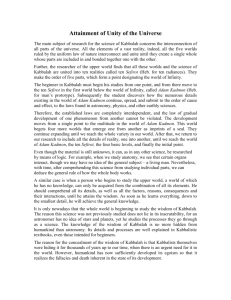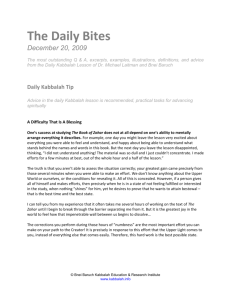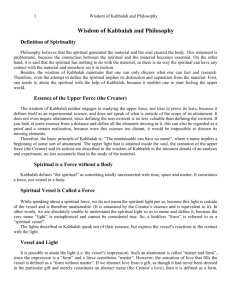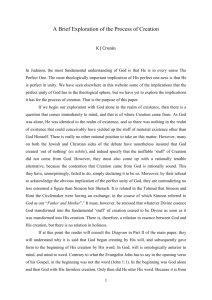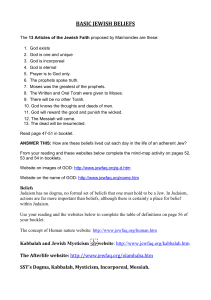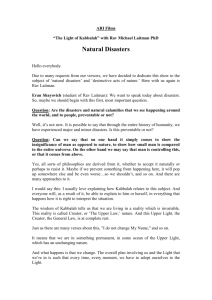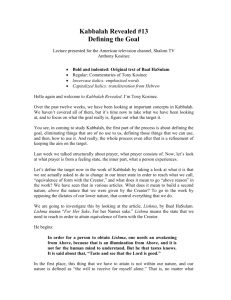Questions Answered by Kabbalist Michael Laitman
advertisement
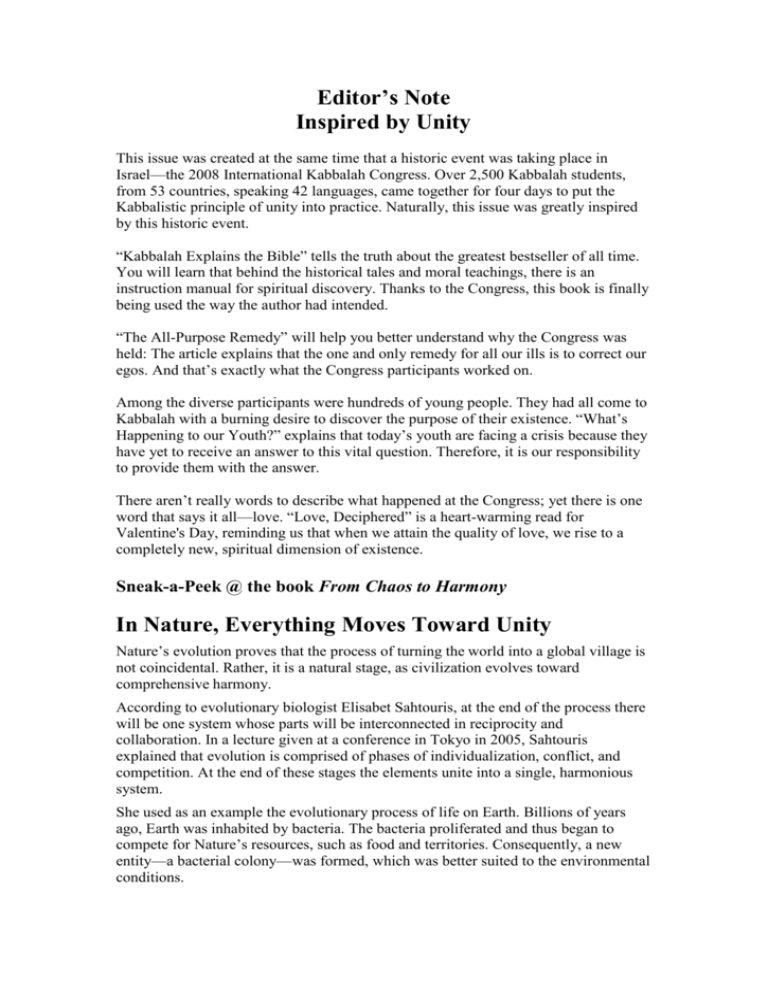
Editor’s Note Inspired by Unity This issue was created at the same time that a historic event was taking place in Israel—the 2008 International Kabbalah Congress. Over 2,500 Kabbalah students, from 53 countries, speaking 42 languages, came together for four days to put the Kabbalistic principle of unity into practice. Naturally, this issue was greatly inspired by this historic event. “Kabbalah Explains the Bible” tells the truth about the greatest bestseller of all time. You will learn that behind the historical tales and moral teachings, there is an instruction manual for spiritual discovery. Thanks to the Congress, this book is finally being used the way the author had intended. “The All-Purpose Remedy” will help you better understand why the Congress was held: The article explains that the one and only remedy for all our ills is to correct our egos. And that’s exactly what the Congress participants worked on. Among the diverse participants were hundreds of young people. They had all come to Kabbalah with a burning desire to discover the purpose of their existence. “What’s Happening to our Youth?” explains that today’s youth are facing a crisis because they have yet to receive an answer to this vital question. Therefore, it is our responsibility to provide them with the answer. There aren’t really words to describe what happened at the Congress; yet there is one word that says it all—love. “Love, Deciphered” is a heart-warming read for Valentine's Day, reminding us that when we attain the quality of love, we rise to a completely new, spiritual dimension of existence. Sneak-a-Peek @ the book From Chaos to Harmony In Nature, Everything Moves Toward Unity Nature’s evolution proves that the process of turning the world into a global village is not coincidental. Rather, it is a natural stage, as civilization evolves toward comprehensive harmony. According to evolutionary biologist Elisabet Sahtouris, at the end of the process there will be one system whose parts will be interconnected in reciprocity and collaboration. In a lecture given at a conference in Tokyo in 2005, Sahtouris explained that evolution is comprised of phases of individualization, conflict, and competition. At the end of these stages the elements unite into a single, harmonious system. She used as an example the evolutionary process of life on Earth. Billions of years ago, Earth was inhabited by bacteria. The bacteria proliferated and thus began to compete for Nature’s resources, such as food and territories. Consequently, a new entity—a bacterial colony—was formed, which was better suited to the environmental conditions. A bacteria is actually a community of bacteria that functions as a single organism. By these very rules, unicellular creatures began to evolve and became multicellular creatures, ultimately comprising complex bodies of plants, animals, and people. Each distinct element has a personal, egoistic interest. However, the essence of evolution is that elements with personal interest unite into a single body and work for the collective interest of that body. Sahtouris regards the process that humanity is presently undergoing as a necessary step to forming a single human family—a community that will provide for the interest of us all, provided we function as healthy parts within it. Thus, if we thoroughly examine Nature’s elements, we will see that altruism is the basis for life. Every living organism and every system consist of an assemblage of cells or parts that cooperate, complement one another, and help one another. They share and survive by the altruistic law, “One for all.” As we look deeper into Nature, we will find more and more examples of Nature’s reciprocal connectedness, and that Nature’s general law is “altruistic bonding among egoistic elements.” Nature designed life in such a way that each cell must become altruistic toward others in order to build a living body. Nature created a regularity by which the adhesive that joins the cells and the organs as a living body is the altruistic relationship among them. Thus, it follows that the force that creates and sustains life is altruistic, a force of giving and sharing. Its objective is to create a life based on altruistic existence, harmonious, and balanced among all its elements. Kabbalah Explains the Bible What does it take to author the greatest bestseller of all time? Apparently, it takes as much as discovering a world where there are no words at all, and finding words from our world to describe it But that’s not all. As a baby, the author of the Bible was found by the daughter of the ancient Egyptian ruler, Pharaoh, lying in a papyrus crib by the banks of the Nile River. He was raised in Pharaoh’s house and lived like a king’s son, having everything one could desire. But one day, Moses found he could no longer remain in that setting and embarked on a journey that led him to discover the Upper World. And even though Moses found himself in different places, the Upper World he discovered was not at all a physical place somewhere on the globe. It was rather an inner world of completely new sensations, unattainable to our regular five senses. When we think about a “world,” the picture that probably pops up in our mind is of some vast physical space filled with all kinds of objects, plants, animals and people. However, the Upper World is sensed through a person’s internality, where one connects to the driving forces behind the reality we perceive through our five senses, called “our world.” And at the highest level of the Upper World, one discovers that all these forces are connected into a single, all-inclusive Upper Force, called “Upper Light.” Words of this World, Meaning of the Upper World Even though Moses wrote his book thousands of years ago, the Bible is still the most famous book ever written. It was originally written in Hebrew, and its Hebrew name, “The Torah,” gives us an insight into its true meaning and intent: The word Torah comes from the Hebrew words Ohr—Light, and Hora’a—instruction. Thus, the book is an instruction manual on how to feel the Upper Light, found in the Upper World that Moses had discovered. But since there are no words in the Upper World, The Torah uses words from this world to describe it. How can our normal words describe the Upper World? Kabbalah explains that the spiritual forces within the Upper World govern everything in our world, and hence, every force in the Upper World is manifested in our world. The forces in the Upper World are called “roots,” and their manifestations in our world are called “branches.” Thus, the language used in The Torah is called “The Language of Branches.” It works like this: When Moses wanted to describe something in the Upper World, he named it after its branch in our world. For instance, if a spiritual object manifests in our world as a stone, he called that spiritual object “a stone.” So the word, “stone,” did not refer to the stone we see and feel in our world, but to the spiritual root that manifests in our world as a stone. In the same way, every word of the Bible describes the happenings of the Upper World. And when read this way, the book is used the way the author had intended: as a guide for one who embarks on the journey of spiritual discovery. When Words Lose Their Meaning Thousands of years have passed since Moses produced this monumental book, and as time went by, the true Kabbalistic meaning of the Bible was forgotten. Instead of reading it in order to enter the Upper World and feel the Upper Light, many people began thinking that the book talked about our world: about relationships between people, moral teachings, and advice on arranging our mundane matters. Others believed that this book was a historical narrative. Either way, these are all misinterpretations of the text, since it is written in the Language of Branches and deals only with the Upper World. And yet, there is archaeological evidence that the historical events described in the Bible actually happened in our world. Do Kabbalists maintain that none of these events actually took place in our world? No, just the opposite: They help us see why they all had to happen in our world. As said above, every object and event in this world is brought about and governed by its root in the spiritual world. Therefore, if a spiritual object exists, it has to manifest in our world as well. That’s why, although the Bible describes only the Upper World, the corresponding events must have taken place in our world as well. Reading Kabbalah Correctly The key discernment here is that Kabbalists consider the spiritual objects and events— the roots—infinitely more important than their material consequences. They explain that a Kabbalist with the exceptional spiritual attainment of Moses could not have written a word with the objective of telling us about history or ethics. Rather, his only purpose would be to reveal the Upper World to mankind, to help us feel it the way he did and thus help us attain the highest goal of our existence. Therefore, the right way to read The Torah is to see that its every word refers to a spiritual force found in the Upper World. Then one begins to gradually connect to these forces and feel them, just as Moses did. Those who have already developed an ability to feel the Upper World are called “Kabbalists,” and when they read The Torah they don’t envision historical events or moral teachings. Instead, they clearly sense how spiritual forces govern us and everything around us, and how everything unites in the infinite, perfect Upper Light. Sneak-a-Peek @ the book Kabbalah for Beginners The Dark before the Dawn The darkest time of night is right before the dawn. Similarly, the writers of The Book of Zohar said, almost 2,000 years ago, that humanity’s darkest time will come right before its spiritual awakening. For centuries, beginning with the Ari, who lived in the 16th century, Kabbalists have been writing that the time The Book of Zohar referred to was the end of the 20th century. They called it “the last generation.” They did not mean that we would all perish in some apocalyptic, spectacular event. In Kabbalah, a generation represents a spiritual state. The last generation is the last and highest state that can be reached. And Kabbalists said that the time we are living in— the beginning of the 21st century—is when we would see the generation of the spiritual ascent, the last state of our evolution. But these Kabbalists also said that for this change to happen, we must change the way we are evolving. They said that today, a conscious, voluntary evolution is required, born of our own free choice to grow. Love, Deciphered Once again, Valentine’s Day is drawing near, with its overabundance of red— red flowers, red hearts, and even red teddy bears. For a fresh shade, Kabbalah is here with a new, eye-opening spin on the notion of love Interestingly, no one is really sure where Valentine's Day comes from. Its intricate history has traces of ancient pagan celebrations of fertility, Greek mythology, dramatic historic twists in the Roman Empire, adoption by the Christian church, and even some very tragic events. But most of all, and whether we like it or not, it is the Western world’s annual reminder of that eternal topic—love. Love—What You Already Knew For some of us, this day is a welcome opportunity to bond with our partners, to buy them flowers and chocolate, and to snuggle in front of a romantic movie. And for some of us, it's a grueling, never-ending day of trying to avoid those “annoying couples,” and to ignore the red hearts that menacingly grin at us everywhere we go, as if saying, “Love is something that was invented just to mock you.” Regardless of which camp you belong to, we have all experienced that feeling of being deeply, hopelessly in love, at least once. Love is blind. When we’re in love, we see no faults in our loved one, justify everything they do, and see only the best in him or her. However, most of us also know that the “love bubble” inevitably pops, and looking back we ask: “Was the love I felt just an illusion? And why can’t I feel now as good as when I was in love?” Love—What Is It Really? Thankfully, the wisdom of Kabbalah introduces an innovative explanation for the love dilemma. First, Kabbalists explain that there's a reason why we feel best precisely when we experience “this thing called love”: because what we feel towards another person somewhat corresponds to the innate quality of Nature. By feeling love, we gain contact with the positive quality that invigorates and binds all parts of reality. Kabbalah calls this quality “love” or “bestowal,” and explains that it is the unifying factor between all the elements in reality: minerals, plants, and animals, as well as all the experiences in man's inner world. All parts of Nature share this quality of universal love—all except man. In other words, man is the only creature that does not enact this quality automatically, the way all other still, vegetative and animate creatures do. We are the sole exception, free to act as we like: to love or to hate, to give or to take, and so on. When We Stand Against Love The fact is that we tend to act contrary to Nature's general quality, and this is the root of all our negative sensations. For some reason, we usually think that we will feel better by doing things to benefit ourselves, even at the expense of others. We focus on “Me, me, me,” “How can I feel better?” and “What can I do to get some more money / fame / power / [fill in the blank] in life?” And many of us know that this pathway to “happiness” is paved with competition, jealousy, loneliness, and pain. Obviously, this is the opposite of how we think when we're in love, when all our thoughts are directed at the other, and all we care about is that person. When we're in love, the only thing on our mind is, “What can I do to make him/her feel better?” If we zoom out of our daily reality for a moment and take a look at ourselves from a broader perspective, it's easy to see that we feel best precisely when we harmonize with the quality of love. Again, this is because we tune our “inner frequency” to the frequency that prevails in all of Nature, to the flow of the whole universe. And this isn't something that only Kabbalah points out. If you ask a biologist or a botanist, they will agree that all living organisms, all life and development, are based on “a law of love.” This is because all parts of a living organism interact according to the principle of “bestowal,” where they constantly give to each other. Each and every cell lives in order to take care of the whole body's essential functions and wellbeing, to sustain its vitality. Our bodies also adhere to Nature's laws in this natural manner, since the body functions on the animate level. It's only on the human level of our interactions—in our thoughts and sensations—that we start veering off in another direction. The human level in us is the place where we feel our “I,” our identity, and our constant concern for ourselves. Since this part of us is focused on personal interest and gain, it usually overlooks the fact that the world is whole, integral, interconnected and interdependent. In other words, we miss the fact that another person's pleasure or pain is inextricably tied to how we will feel, and that our well-being depends directly on other people's well-being. Kabbalah helps us refocus and look at what's going on “under a magnifying glass.” We then see that Nature’s law of absolute love—of universal, instinctive, natural attention and care—is far from being realized on the human level. We Feel Infinite Love by Harmonizing with Nature If we change this tendency, and begin regarding everyone according to the natural law of bestowal, then we will feel that wonderful feeling of “love” all the time, not just at brief moments. It’s because once we realize that we’re all interconnected, just as the cells of our body are, we will participate in Nature’s flow as integral elements. We will simply merge with the rest of Nature, and our attitude to it—to everything around us—will be pure love. This harmonizing with Nature on the human level will bring us a sense of what Kabbalah calls “Infinity”—infinite love, joy and peace. This feeling is called “Infinity” because when we sense it, the boundaries between us simply vanish, and we literally feel others as if they were a part of us. Therefore, a relation of love and bestowal isn't just a change of attitude, but a fundamental upgrade of our quality of life and the range of our perception. So let's not spend this Valentine's Day sulking about those “annoying couples,” or wondering why it never worked out with that ex. Instead, let it be a reminder of the infinite love we can experience when we shift our focus from reception to bestowal. Making Room for the Creator If you build a desire for the Creator, He will reveal Himself in it. The wisdom of Kabbalah explains how “If you build it, he will come.” This whisper from beyond the grave in the 1989 film, Field of Dreams, led Kevin Costner’s character to rearrange his life so he could build a baseball diamond. By doing so, he enabled deceased baseball players to miraculously appear and play a game of baseball that they had not had a chance to play during their lives. But only Costner’s character could see the baseball players; he was the only one who could interact with them. Somewhat similarly, Kabbalists state that if we build a place for the Creator, He will emerge in this place and fulfill it. But only the person who builds this place will be able to feel Him and interact with Him. Attraction to the Unknown Unlike the mysterious voice in the film, the call to build a new “place” for the Creator starts with a feeling: an attraction to something unknown, beyond the boundaries of our entire life experience. First, we begin to search for something without knowing exactly what it is. We ask questions like, “What's the point of my life?” “Where did I come from and where am I going?” and we feel that we must have them answered. The quest for something unknown indicates that a new desire has awakened in us—a desire to discover life's source. And this desire is precisely the “place” where the Creator will eventually appear. This is not a physical place, but a place within our internality. It is a desire in our hearts that Kabbalists call “a point in the heart,” which gradually grows from a small point to an entire “place” where the Creator becomes revealed. This place, which starts out as a point in the heart, eventually grows into “the soul”—the vessel that holds the presence of the Creator. The Soul - The “Place” to Build So He Will Come Kabbalah explains that no one is born with a fully grown soul. It is rather something we create gradually. Our initial desire for something new and unknown is an initial “point” of the soul, which can be developed into a fully grown, eternally existing soul. It can be compared to the little dot of a fetus that you see in ultrasound photographs after just two months of its development in the womb. However, unlike the case of a fetus developing into a baby, a point of the soul does not grow into a soul by us just sitting there and waiting for the developmental process to run its course. Rather, the process of developing our initial “point in the heart” into a fully grown soul is completely up to us. It depends on our active participation and the efforts we make to build this “place.” And to the extent that we cause the initial point to grow, we begin feeling the Creator within it. The Wisdom of Kabbalah – the Tools for Building the Soul The wisdom of Kabbalah provides the tools for us to grow our souls, the place for the Creator’s revelation. This method offers guided advice and instruction on how to work with that inner point, how to differentiate it from all the other desires one has, how to understand what it is and where it comes from, and how to assume responsibility for it. All this allows us to nurture this point and grow it into a fully developed soul. What happens when the growth is completed, when the “place” is ready? The Creator immediately appears in it and fills this desire with sensations of eternity and perfection. These sensations come from connecting to our life’s source, which is perfect and eternal. Such an attainment, called “the revelation of the Creator,” is the goal of Kabbalah study. In fact, the entire method of Kabbalah is aimed at building this “place” for the Creator’s revelation. Questions Answered by Kabbalist Michael Laitman on his Weekly Live TV Show, “Ask the Kabbalist” Rising Above the Ego to a New Level of Consciousness Q: After reading one of your books, I realized that all my actions are directed by the inner formula of “the will to receive”: getting maximum benefit with minimal effort. Yet, I still wonder: Do I have any say in what happens to me? Can I influence anything in my life? A: Your realization is completely correct: “The will to receive” is, indeed, a very powerful force that exists within us and motivates everything we do. And from this perspective, it does seem as if we are helpless, like puppets pulled by strings. However, we do have the ability to rise above this level of existence: The trick is to learn how to use “the will to receive” or the ego correctly. This means using it in order to attain the spiritual goal. By so doing, we don’t try to eliminate the ego, but instead learn how to use it correctly, without harming ourselves or others. Studying Kabbalah helps us rise above the ego’s formula and take matters into our own hands. This is done by developing a higher level of consciousness, called “intention.” On that level, we are not focused on “what am I doing?” but rather “why am I doing?” We begin exploring a completely new realm, hidden from the five senses and broader than the ego’s field of view, called “the spiritual world.” Here, we can freely determine the nature of our actions and learn how to use the ego’s force to our advantage. Q: I also understood that we are completely governed by inborn qualities and the values we receive from society. In other words, we are like robots following a program. Are you now saying that the “intention” allows us to run the program rather than follow it? A: Exactly. Without the intention, we act according to predetermined qualities that we did not choose, and we constantly respond to external influences that we cannot control. We behave much like robots that react to incoming data according to their programs, with every response predictable. However, having an intention gives us a completely new point of view. It allows us to observe ourselves from a place that is free from the program’s control. Kabbalists call this place a “point in the heart,” and explain that it’s the beginning of our connection with the Upper Force that governs us—the Creator. Q: So how do I know if I have that “point in the heart”? A: Everyone has it, but in some of us, it is still buried deep under other desires, dormant. You know that your point in the heart has awakened, or surfaced, when you start having questions like: “What am I living for?” “What is the reason for everything that happens?” and “Where does it all end?” These questions come from the point in the heart and are answered from a higher level of existence, where we are connected with the source of life. And as was already mentioned, “the point in the heart” is our initial connection with the Source of life, the Creator. That is why it raises questions about the source and purpose of everything. Kabbalah is a method that’s intended specifically to help us answer the questions that come from “the point in the heart.” Once you start using this method, you gradually expand this inner point into a higher level of consciousness, connecting to the Creator more and more. In the process, a completely new picture of reality opens up before you. The All-Purpose Remedy The World Health Organization reports that nearly 40 new diseases have emerged in the last 30 years, over 1,100 epidemic events took place in the last 5 years alone, and mental illnesses have become a plague. According to Kabbalah, one principal flaw stands behind all of this—human egoism. “The disease situation is anything but stable... New diseases are emerging at the historically unprecedented rate of one per year,” writes the World Health Organization’s Director-General in the recent World Health Report. “In a particularly ominous trend, mainstay antimicrobials [substances used against harmful microbes] are failing at a rate that outpaces the development of replacement drugs. These threats have become a much larger menace in a world characterized by high mobility, economic interdependence and electronic interconnectedness... Vulnerability is universal.” The name of this report, “A Safer Future,” implies an optimistic view of the situation. However, a quick glance indicates that our future is far from secure. This lengthy report reveals the many illnesses that are currently affecting humanity, as well as those that will affect us in the future. And what does modern medicine have to say about this? Well, the news is hardly reassuring. Along with the rise of existing illnesses such as diabetes, heart disease and depression, the report also warns that “It would be extremely naive and complacent to assume that there will not be another disease like AIDS, another Ebola, or another SARS, sooner or later.” Why Is This Happening to Us? It seems that doctors have been finding it difficult to provide clear, direct answers to this question. However, according to the writers of this report, one thing is certain: Public health is primarily at risk because of human behavior. As surprising as it may sound, Kabbalists also wrote about future illnesses that could afflict humanity in the 21st century. Like today’s doctors, they asserted that man plays a central role in these afflictions, and they also provided a possible solution to the health threat we face today. But what do Kabbalists know about medicine, you ask? Modern medicine defines an illness as the disruption of the process of homeostasis— balance in our bodies. When the function of a cell or an organ is disrupted, balance in the body is also disrupted, and as a result we become ill. In order to overcome the illness, the body does everything in its power to restore balance to all of its systems. However, Kabbalists say that the process of balancing doesn’t take place only in the body. Similarly to modern science, Kabbalah explains that there is an ongoing process of homeostasis within all of Nature. In early writings, Kabbalists describe Nature as a closed, integral system, in which all the parts cooperate in perfect balance and harmony. And this magical balance is kept by the reciprocal concern among the different parts of Nature. Prof. Guntar Blubel, a Nobel Prize laureate in physiology and medicine, noted for his research on cell multiplication, recently told a Kabbalah Today reporter that according to scientific findings, “The principle of reciprocity is the key to the existence of every system in Nature. The cells in a living body illustrate the best example. They connect to one another by mutually giving to the body as a whole. Every cell receives everything it needs for its existence and uses all of its powers to care for the whole body.” Good Health=A Good Relationship with Nature Like the cells in our body, every individual element, on every level of Nature, acts in favor of the whole to which it belongs, and thus finds its wholeness. When a certain individual breaks the balance in Nature, all of Nature’s systems are immediately recruited to level the pressures and to restore the balance that was disrupted. For instance, when the inner pressure at the earth’s core grows, and the external layer of the earth can’t withstand the pressure any longer, a volcano erupts. According to Kabbalah, new illnesses that erupt today are but a manifestation of the increasing imbalance in man’s relationship with Nature. The thing that slips our notice is that humans are also part of Nature’s integral system, just like all the minerals, plants and animals. Therefore, the rules that apply to Nature’s integral system also apply to us. Finding out what those rules are is exactly what will allow us to find the reason for—and the solution to—our problems. “Root Treatment” It’s no news to anybody that egoism in human society is constantly on the rise. One takes advantage of another, enjoys the suffering of others, and empowers oneself through the destruction of others. With his egoistic attitude, man diverts from the course of Nature, systematically breaking the law of balance and reciprocity, and as a result suffers a painful reaction from Nature itself. One way or another, Nature always balances whatever it finds to be imbalanced. The egoistic attitude that has become so prevalent in modern society is like a boomerang: It returns to hit us with more illnesses as well as other troubling phenomena that we are having a hard time explaining. Even with the vast amounts of resources and technology we invest in our health systems, we barely scratch the surface of the problem. Instead of trying to fight every new symptom that emerges, it is time to treat the root of the problem—human egoism. However, this does not mean that as of tomorrow we should say goodbye to our doctors. Rather, even as we keep visiting medical clinics, we must start treating the problem at the root and correct human egoism. Kabbalah shows us how to broaden our perception and see that we are all parts of the same system. We will thereby restore our balance with Nature, and most of the illnesses will simply disappear, as their main cause will cease to exist. Thus, “correcting our egos,” Kabbalists say, is the all-purpose remedy. The War of the Sexes “The man is the head of the family!” “No way! Everything in a relationship depends on the woman. The woman makes the man!” and so on and so forth. Who's right and who's wrong? And who really dominates a relationship? Kabbalah says: neither! In a healthy relationship, the Creator is the one who dominates. But what does the Creator have to do with our relationships, you might ask? According to Kabbalah, “the Creator” is the quality of unconditional love and giving. And when spouses wish to attain this quality, they rise above egoism and no longer need to fight over who's right and who's wrong. It becomes easier to make concessions to one another if the goal is to attain the spiritual qualities of love and bestowal. In fact, by sharing this common goal they begin to love one another even more, because by pursuing the quality of absolute love and bestowal, they expand their ability to love and give to each other. But most importantly, they learn how to love and give to the Creator. Such a relationship changes the rules in the War of the Sexes: The winner is the one who loves most. What’s Happening to Our Youth? More and more youngsters are succumbing to drugs, depression and horrendous acts of violence. What has brought about the crisis our young generation is facing? Kabbalah explains that it’s their desire that’s in crisis, as they can no longer fulfill it with what we try to give them As I sit down to read the newspaper, the headlines hit me once again. A teenager stepped into a crowded holiday shopping mall and opened fire, killing eight people. What could lead a young person with a bright future ahead of him to commit such a desperate act? Meanwhile, a dear friend’s niece clings to life in a hospital after swallowing a bottle of pills in a suicide attempt. Depression among teenagers has reached epidemic proportions. What is happening to our youth? Shouldn’t teens be too young to be overwhelmed by feelings of despair and hopelessness? There are many countries in the world where despair would be understandable—countries where unbelievable hardship, poverty, starvation and violence are the daily reality. But this is the United States—many of these kids come from affluent, loving homes where they have every advantage that money can buy. At the other end of the spectrum, we see a growing number of people who are stuck in childhood—even into their twenties, thirties and beyond. They might trade in their Hot Wheels toy cars for the real thing and get involved in more expensive “games,” but they are still children who rebel against assuming any type of responsibility in the adult world. We see the impact in areas as diverse as the breakdown of American families, the record number of bankruptcy filings, and the trouble businesses are having hiring responsible, mature workers. Although it’s hard to admit, both youth and adults are facing a social crisis, and no one seems to quite know why. Talk show hosts have become millionaires by expounding on these problems and interviewing “experts.” Politicians push their proposed social reform programs, and communities pass more and more laws in an effort to control behavior, but these are all knee-jerk reactions to the problem. In order to affect real change, we must find the source of the problem. The wisdom of Kabbalah presents an intriguing perspective on the roots of societal discord, revealing a common thread behind all the unpleasant phenomena that we are witnessing. Identifying the Source In order to identify the reason behind our youth’s behavior, we first have to examine our very nature and see how it evolves. Kabbalah maintains that the motivating force behind all of our actions is our desire to receive pleasure. In other words, every action that a person takes, no matter how small, is prompted by some desire for some pleasure. But there’s more: This desire for pleasure continuously evolves within humanity, propelling us to constantly seek new kinds of pleasures. This evolution started with our most basic desires: those we must fulfill to survive, such as desires for food, sex and shelter. In other words, ages ago, having a good meal and a roof over one’s head was the ultimate bliss. At a later point in humanity’s evolution, new kinds of desires emerged—social desires. These desires emerge due to the fact that people interact within society, and they include desires for wealth, fame and power. We have evolved through these social desires for thousands of years, actualizing every possible combination and aspect of them. From this perspective, film stars, sports idols or politicians are all “manifestations” of the social desires that evolve within humanity. But today, Kabbalists explain, a new kind of desire is emerging within humanity, one that we can neither fulfill through our bodies nor through other interactions with each other. This desire is still hard for us to define, and we don’t really know how to fulfill it—it is the desire to realize the purpose of our existence. While there have always been individuals in every generation who wondered, “Why am I here?” now is the first time in history that this question is awakening in masses of people, and demanding to be answered. The Price of Dissatisfaction So how does this relate to the crisis our younger generation is facing? Because they are at the peak of the evolution of desires, they inherently sense that money, fame and power will not lead them to true happiness. This doesn’t mean that the kids of today have no desire for anything; on the contrary, they have a huge desire: they just don’t know how to satisfy it. It’s quite simple: If I really want a puppy for my birthday, I’m not going to be happy if you give me a new set of clothes. Even if the clothes look really nice on me, they simply won’t match the desire I have within me. For our youth, it’s like that with any kind of pleasure. They go from one desire to the next at lightening speed, and continue to find themselves unsatisfied. By the time they are teens, many children are disillusioned and cynical about their parents’ ability to show them how to be happy. They don’t see why they should work hard to achieve the goals that adults set for them. On the other hand, they don’t know what else to strive for. To us, it may look like today's kids are lazy, but their lack of motivation is really an expression of hopelessness. In extreme cases, their despair is so painful that life itself seems pointless and suicide seems to be the only answer. To cope, many teenagers adopt a “Life is short; eat dessert first” attitude, spending their time chasing after any pleasure, as long as it is easy to obtain. The result is the “perpetual child,” unable to maintain a family or work relationship once it requires real effort. These kids are also vulnerable to the appeal of drugs, alcohol, and get-richquick schemes, since all of these promise intense pleasure for virtually no effort. Other teens react to their sense of emptiness with anger, lashing out at parents and a society that have been unable to provide them with a meaningful purpose for their lives. And sometimes this anger erupts in horrendous violence, such as the mall shootings. Answering Their Needs The younger generation’s inability to understand and fulfill their desires is the very source of their problems. Without guidance from previous generations, teens are groping in the dark as they try to find ways to satisfy this nameless desire within them. The popularity of films such as The Matrix, Lord of the Rings, and Harry Potter reflects the desire for something beyond what we can find in this world. The explosion of interest in New Age religions, mysticism and Eastern philosophies also points to the growing need young people feel to find meaning in life. In order to help our children, we must let them know that there is a reason for the emptiness and confusion that they feel. We need to show them where they fit into humanity’s general course of development—and let them see that they represent the final phase in the evolution of desires. And we have to provide them with a way to develop and fulfill their desires. Kabbalah can help us provide such guidance by giving youth a tangible understanding of the purpose of their existence. And once our children know what their purpose is, they will be motivated to go after it. Apathy, anger, depression and despair will give way to the same passionate energy with which their parents and grandparents pursued the “American dream” —the quest for money, honor and fame. Our children will be able to go places and achieve states of unbounded happiness, but we must provide them with the tools and guidance for their journey. By so doing, we will save them a lot of misery, allow them to find true happiness, and hasten everyone’s way towards the true purpose of existence. Kabbalah, the Creator and the Unity of Mankind Although we often feel like isolated individuals and see a world of schisms, Kabbalists say that we are all interconnected and interdependent. Much like the cells of a living body, we are all parts of a single entity called “the collective soul.” Our individual souls are bound together by an Upper Force that can only be described as complete, unconditional love and bestowal. This force not only connects us together, but all other parts of Creation as well—it is Nature’s all inclusive force, “the Creator.” Those who have developed the ability to perceive this force and the collective human soul are called “Kabbalists.” They explain that this ability lies within each of us, but remains dormant until we develop it. And from their perspective, it is evident that in the coming phase of human evolution, all people will discover that they are unified, will connect to the Upper Force that unites them, and will thereby find true happiness. To help us get there, Kabbalists gave us the wisdom of Kabbalah—a method by which we can develop our ability to perceive humanity’s collective soul, and connect to the Creator—the Upper Force that enlivens the whole of Creation.

